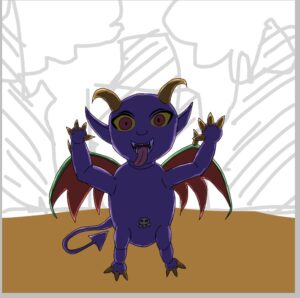Hello. This time I would like to finish the rough background.
1. First, let's decide on the rough background.

A rough sketch is a rough draft to decide the rough composition and shape before drawing a picture. By drawing a rough sketch, you can check the balance and composition of the whole picture. First, imagine what kind of picture you want to draw and draw it roughly on paper. At this stage, it is important to decide the big shape and placement without getting too hung up on the details.
Next, it is important to start with the big shape and draw simply.
The basics of rough sketches are to decide the big shape and position of the object you want to draw. For example, decide the position of the character or building, and draw the rough shape of the background accordingly.
Draw the rough sketch simply. Fine details will be drawn later, so express it with simple lines and shapes at first.
If you are unsure about the rough sketch, try thinking of several ideas.
Don't stick to one rough sketch, try drawing several patterns. Trying different compositions and perspectives can help you find better ideas.
2. Consider the composition of the background.

The composition of the background is an important factor in determining the overall atmosphere and impression of the picture. When drawing a background, it is important to carefully consider the composition.
It is also important to consider depth and decide on the viewpoint.
When drawing a background, it is important to give the picture a sense of depth. Drawing distant objects small and close objects large will create a three-dimensional effect in the picture.
The viewpoint determines the angle from which the background will be drawn. The atmosphere of the background will change depending on the viewpoint, whether it is from the front, at an angle, or looking down from above.
It is also important to be conscious of balance in the background.
Consider the balance between the background and the main character or object. If the background is too strong, the main character will be buried, so make the composition stand out.
3. How to finish the rough draft

Once the rough draft is decided, you can then finish it little by little. At this stage, you will draw in the fine details and refine the lines.
Next, we will explain the importance of refining lines, adding details, and being aware of white space.
Gradually refine the rough lines drawn in the rough sketch stage. By making the lines neater, the picture will become clearer.
Add the necessary details to the background, such as buildings, trees, and mountains. At this time, keep in mind the composition decided in the rough sketch stage and draw in a balanced way.
When drawing the background, be aware of white space (blank areas). Do not fill everything, but lea ve white space to give the picture space to breathe.
4. Consider the color arrangement for the background.

Before coloring the background, think about what colors you will use. The color arrangement has a big impact on the atmosphere and theme of the picture.
Next, choose colors that will bring out the main subject, and at the same time try to use natural color combinations and different shades of color.
The color of the background plays the role of bringing out the main subject. For example, if the main subject is a bright color, it is good to use a slightly muted color for the background.
When drawing a natural landscape, choose a color combination that looks natural. For example, use real-life colors as a reference: blue for the sky, green for the grass, and brown or green for the trees.
You can add depth to your painting by drawing distant objects in light colors and close objects in dark colors.
It's also important to review the whole picture.
Look at the whole picture and make sure it's balanced and the colors blend together. If necessary, correct the colors and lines.
Conclusion
How to draw the background and decide on the rough sketch are important methods for drawing a picture. By drawing a rough sketch carefully and thinking about the composition and colors of the background as you proceed, you will end up with a highly finished picture. It may be difficult at first, but you can get the hang of it by practicing repeatedly. Once you can draw the background well, the whole picture will stand out much more. Ha ve fun and proceed at your own pace.